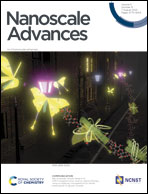Strain-induced Mn valence state variation in CaMnO3−δ/substrate interfaces: electronic reconstruction versus oxygen vacancies
Abstract
This study investigates the nanoscale crystalline and electronic structures of the interfaces between CaMnO3−δ and substrates such as SrTiO3 (001) and LaAlO3 (001) by employing advanced transmission electron microscopy and electron energy loss spectroscopy techniques. The objective is to comprehend the influence of different strains on the Mn valence state. Our findings reveal that the Mn valence state remains relatively stable in the region of a weakly tensile-strained interface, whereas it experiences a significant decrease from Mn4+ to Mn2.3+ in the region of a strongly tensile-strained interface. Although this reduction in valence appears to be consistent with the electron reconstruction scenario, the observed increase in the out-of-plane lattice constant at the interface implies the accumulation of oxygen vacancies at the interface. Consequently, the present study offers a comprehensive understanding of the intricate relationships among the Mn valence state, local structure, and formation of oxygen vacancies in the context of two distinct strain cases. This knowledge is essential for tailoring the interface properties and guiding future developments in the field of oxide heterostructures.



 Please wait while we load your content...
Please wait while we load your content...